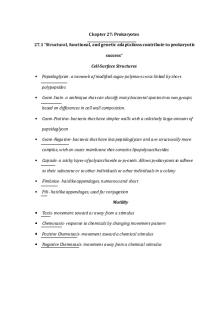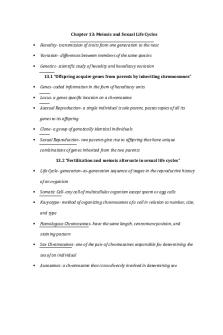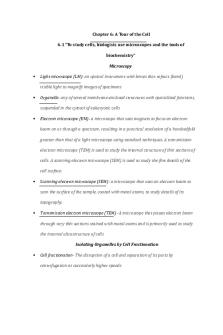Chapter 27 Vocab - Summary Campbell Biology PDF

| Title | Chapter 27 Vocab - Summary Campbell Biology |
|---|---|
| Course | Introduction to Biology A |
| Institution | University of Pennsylvania |
| Pages | 5 |
| File Size | 100 KB |
| File Type | |
| Total Downloads | 96 |
| Total Views | 130 |
Summary
Vocab definitions...
Description
Chapter 27: Prokaryotes 27.1 “Structural, functional, and genetic adaptations contribute to prokaryotic success” Cell-Surface Structures
Peptidoglycan- a network of modified-sugar polymers cross-linked by short polypeptides
Gram Stain- a technique that can classify many bacterial species into two groups based on differences in cell wall composition.
Gram-Positive- bacteria that have simpler walls with a relatively large amount of peptidoglycan
Gram-Negative- bacteria that have less peptidoglycan and are structurally more complex, with an outer membrane that contains lipopolysaccharides
Capsule- a sticky layer of polysaccharide or protein. Allows prokaryotes to adhere to their substrate or to other individuals or other individuals in a colony
Fimbriae- hairlike appendages, numerous and short
Pili- hairlike appendages, used for conjugation Motility
Taxis- movement toward or away from a stimulus
Chemotaxis- response to chemicals by changing movement pattern
Positive Chemotaxis- movement toward a chemical stimulus
Negative Chemotaxis- movement away from a chemical stimulus
Internal and Genomic Organization
Nucleoid Region- where prokaryotic chromosomes are located; part of the cytoplasm that appears lighter than the surrounding cytoplasm in electron micrographs
Plasmids- small rings of DNA that consists of only a few genes; provide resistance to antibiotics, direct the metabolism, and other contingency functions Reproduction and Adaptation
Endospores- resistant cells that form when essential nutrient is lacking from the environment 27.2 “A great diversity of nutritional and metabolic adaptations have evolved in prokaryotes”
Photoautotrophs- photosynthetic organisms that capture light energy to use it to drive the synthesis of organic compounds from CO₂ (Cyanobacteria); obtain energy from the light
Chemoautotrophs- organisms that only need CO₂ as a carbon source. Instead of light energy, they oxidize inorganic substances, such as hydrogen sulfide (H₂S), Ammonia (NH₃) or ferrous ions (Fe²⁺); obtain energy from chemicals
Photoheterotrophs- organisms who use light for energy but must obtain their carbon in organic form
Chemoheterotrophs- organisms that must organic molecules for both energy and carbon
Metabolic Relationships to Oxygen
Obligate Aerobes- prokaryotes that use O2 for cellular respiration and cannot grow without it
Facultative Anaerobes- prokaryotes that use O2 if it is present but can also grow by fermentation in an anaerobic environment
Obligate Anaerobes- poisoned by O2
Anaerobic Respiration- The use of inorganic molecules other than oxygen to accept electrons at the "downhill" end of electron transport chains Nitrogen Metabolism
Nitrogen Fixation- a process where prokaryotes convert nitrogen (N₂) to ammonia (NH₃) to be incorporated into amino acids and other organic material Metabolic Cooperation
Anabaena- a cyanobacterium that has genes encoding proteins for photosynthesis and nitrogen fixation, but cannot do these processes simultaneously
Heterocytes- specialized nitrogen-fixing cells
Biofilms- a surface-coating colony of prokaryotes that engage in metabolic cooperation 27.3 “Molecular systematics is illuminating prokaryotic phylogeny” Archaea
Extremophiles- lovers of extreme conditions. Include extreme thermophiles, extreme halophiles, and methanogens
Extreme Thermophiles- prokaryotes that thrive in very hot conditions
Extreme Halophiles- prokaryotes that thrive in highly saline environments, such as the Great Salt Lake and the Dead Sea
Methanogens- prokaryotes that use CO2 to oxidize H2, releasing methane as a waste product 27.4 “Prokaryotes play crucial roles in the biosphere”
Decomposers- organisms that break down corpses, dead vegetation and waste products thereby unlocking supplies of carbon, nitrogen, and other elements Symbiotic Relationships
Symbiosis- ecological relationship between organisms of different species that are in direct contact
Host- larger symbiotic organism
Symbiont- smaller symbiotic organism
Mutualism- an ecological relationship where both symbiotic organisms benefit
Commensalism- an ecological relationship where one organism benefits while neither harming nor helping the other in any significant way
Parasitism- an ecological relationship where one organism benefits at the expense of the host
Parasite- an organism that lives in or on another organism (its host) and benefits by deriving nutrients at the host's expense 27.5 “Prokaryotes have both harmful and beneficial impacts on humans” Pathogenic Prokaryotes
Exotoxins- proteins secreted by prokaryotes (Cholera)
Endotoxins- lipopolysaccharide components of the outer membrane of gramnegative bacteria. (Salmonella) Prokaryotes in Research and Technology
Bioremediation- the use of organisms to remove pollutant from soil, air, or water...
Similar Free PDFs

Ch26 - Summary Campbell Biology
- 6 Pages
Popular Institutions
- Tinajero National High School - Annex
- Politeknik Caltex Riau
- Yokohama City University
- SGT University
- University of Al-Qadisiyah
- Divine Word College of Vigan
- Techniek College Rotterdam
- Universidade de Santiago
- Universiti Teknologi MARA Cawangan Johor Kampus Pasir Gudang
- Poltekkes Kemenkes Yogyakarta
- Baguio City National High School
- Colegio san marcos
- preparatoria uno
- Centro de Bachillerato Tecnológico Industrial y de Servicios No. 107
- Dalian Maritime University
- Quang Trung Secondary School
- Colegio Tecnológico en Informática
- Corporación Regional de Educación Superior
- Grupo CEDVA
- Dar Al Uloom University
- Centro de Estudios Preuniversitarios de la Universidad Nacional de Ingeniería
- 上智大学
- Aakash International School, Nuna Majara
- San Felipe Neri Catholic School
- Kang Chiao International School - New Taipei City
- Misamis Occidental National High School
- Institución Educativa Escuela Normal Juan Ladrilleros
- Kolehiyo ng Pantukan
- Batanes State College
- Instituto Continental
- Sekolah Menengah Kejuruan Kesehatan Kaltara (Tarakan)
- Colegio de La Inmaculada Concepcion - Cebu














